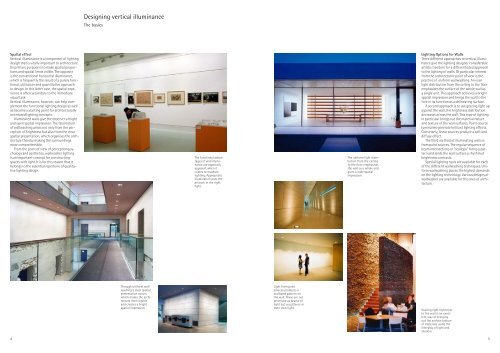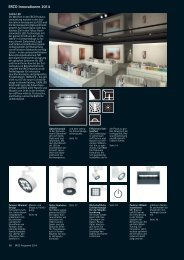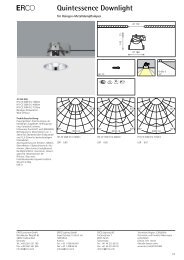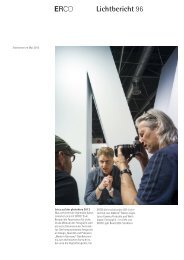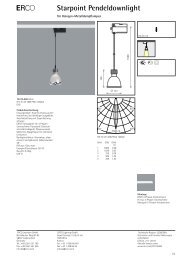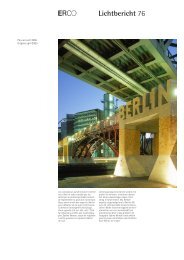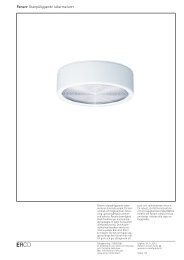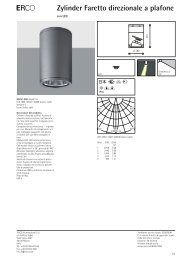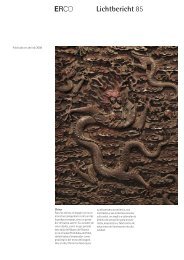Vertical Illuminance - Erco
Vertical Illuminance - Erco
Vertical Illuminance - Erco
You also want an ePaper? Increase the reach of your titles
YUMPU automatically turns print PDFs into web optimized ePapers that Google loves.
Spatial effect<br />
<strong>Vertical</strong> illuminance is a component of lighting<br />
design that is vitally important to architecture.<br />
Its primary purpose is to make spatial propor-<br />
tions and spatial limits visible. The opposite<br />
is the conventional horizontal illuminance,<br />
which is frequently the result of a purely functional,<br />
utilitarian and quantitative approach<br />
to design. In this latter case, the spatial experience<br />
is often secondary to the immediate<br />
visual task.<br />
<strong>Vertical</strong> illuminance, however, can help complement<br />
the functional lighting design as well<br />
as become a starting point for architecturally<br />
orientated lighting concepts.<br />
Illuminated walls give the observer a bright<br />
and open spatial impression. The fascination<br />
of wallwashing arises not only from the perception<br />
of brightness but also from the clear<br />
spatial presentation, which organises the architecture<br />
thereby making the surroundings<br />
more comprehensible.<br />
From the point of view of perception psychology<br />
and aesthetics, wallwasher lighting<br />
is an important concept for constructing<br />
spaces with light. It is for this reason that it<br />
belongs to the essential repertoire of qualitative<br />
lighting design.<br />
4<br />
Designing vertical illuminance<br />
The basics<br />
Through uniform wallwashing<br />
a clear spatial<br />
presentation occurs,<br />
which makes the architecture<br />
more legible<br />
and creates a bright<br />
spatial impression.<br />
The functional advantages<br />
of wall illuminance<br />
are especially<br />
apparent when it<br />
comes to museum<br />
lighting. Appropriate<br />
illumination puts the<br />
artwork in the right<br />
light.<br />
Light from point<br />
sources produces a<br />
scalloped pattern on<br />
the wall. These are not<br />
perceived as beams of<br />
light but as patterns in<br />
their own right.<br />
The uniform light distribution<br />
from the ceiling<br />
to the floor emphasises<br />
the wall as a whole and<br />
gives a wide spatial<br />
impression.<br />
Lighting Options for Walls<br />
Three different approaches to vertical illuminance<br />
give the lighting designer considerable<br />
artistic freedom for a differentiated approach<br />
to the lighting of walls. Of particular interest<br />
from the architectonic point of view is the<br />
practice of uniform wallwashing. An even<br />
light distribution from the ceiling to the floor<br />
emphasises the surface of the whole wall as<br />
a single unit. This approach achieves a bright<br />
spatial impression and brings the wall to the<br />
fore in its function as a delineating surface.<br />
A second approach is to use grazing light up<br />
against the wall, the brightness distribution<br />
decreases across the wall. This type of lighting<br />
in particular brings out the material nature<br />
and texture of the wall surfaces. Point-source<br />
luminaires generate brilliant lighting effects.<br />
Conversely, linear sources produce a soft and<br />
diffuse effect.<br />
The third method of illuminating walls is<br />
from point sources. The regular sequence of<br />
beam intersections or “scallops” forms a pattern<br />
and lends the wall surface a rhythm of<br />
brightness contrasts.<br />
Special lighting tools are available for each<br />
of the different wallwashing techniques. Uniform<br />
wallwashing places the highest demands<br />
on the lighting technology. Various designs of<br />
wallwasher are available for this area of architecture.<br />
Grazing light right next<br />
to the wall is an excellent<br />
way of bringing<br />
out the surface texture<br />
of materials using the<br />
interplay of light and<br />
shadow.<br />
5


